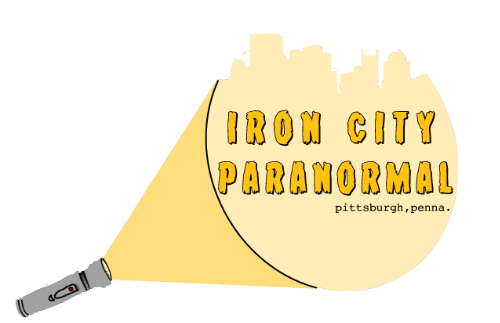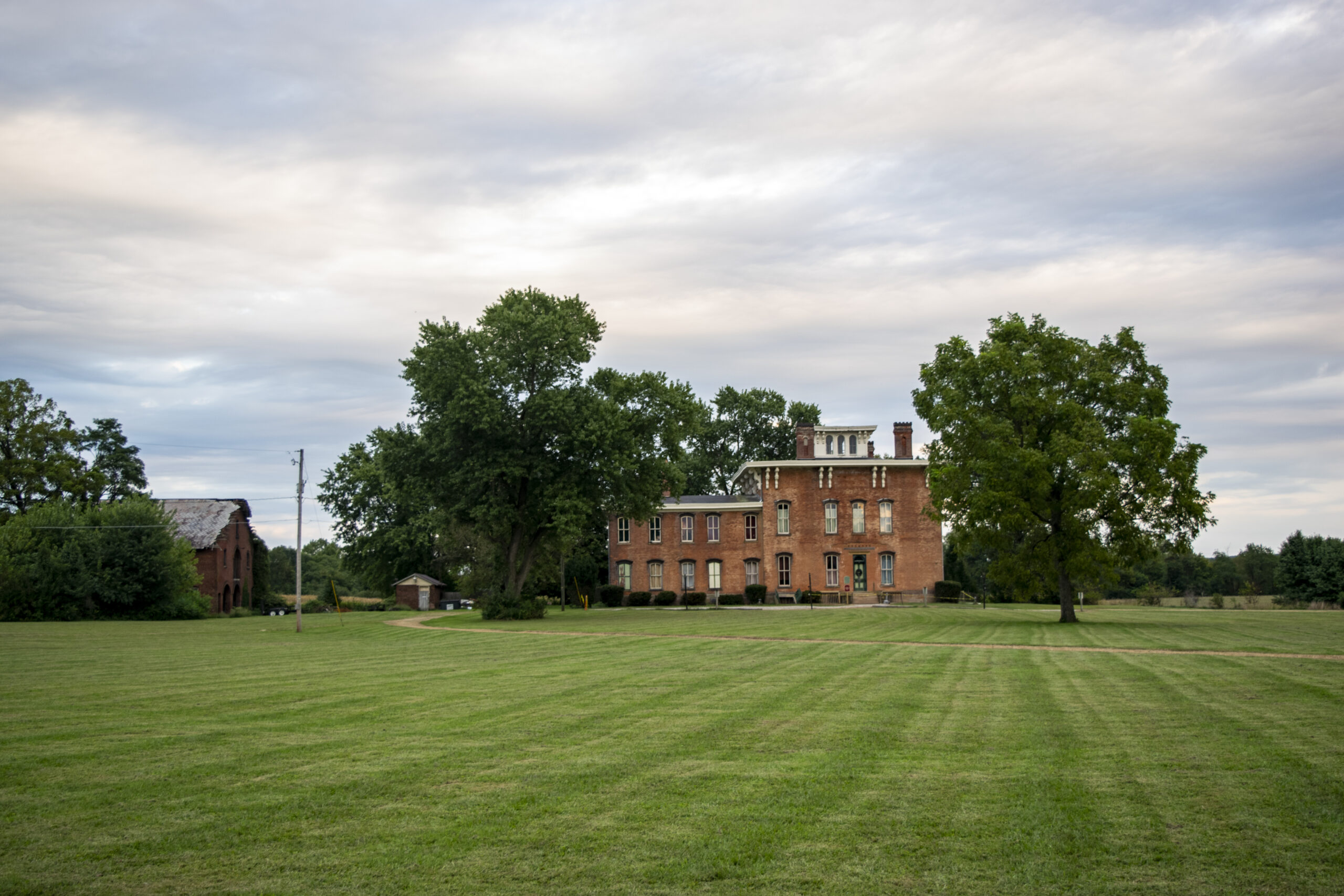Prospect Place hosts such a value to not only the area, but all of history as well. Currently as an education center teaching about the Underground Railroad and local history, Prospect Place was once home to a twelve-member family and a stop for an unknown number of slaves on the run. The house served as an encampment during the Civil War and a shelter to help those in need. The good deeds of the owners far outweigh the death and tragedy of the time period, but the mansion still hosts a large sum of souls who do not even know they are past their expiration – yet some others who simply do not want to leave their former home. Visitors can experience history and other worldly entities, whether they believe in the afterlife or not. Thanks in large part to the family of the original owner, Prospect Place still thrives on those who want to keep the past alive and others who want to believe in something else. The mansion has withstood the test of time and is open to all those interested in exploring the past hands on, no matter what their belief system.

The Past
The 29-room mansion is hidden in plain site in the small town of Trinway, Ohio. Prospect Place was constructed in 1856, right before the Civil War, by George Willison Adams – a well-known abolitionist. George inherited this trait from his father as they moved from Virginia to Ohio when he was only 8 years old. His parents freed their slaves and sold their plantation for a new life away from the cumbersome and daily disagreements that came with the slave trade.
Being one of thirteen children, George pulled away from his parents but kept a close bond to one of his brothers, Edward. This bond was so tight in fact, that they opened a flouring mill in nearby Dresdon, Ohio with their inheritance from the Virginia plantation around 1830. Their joint venture of Adams Mills not only brought them wealth, but also allowed them to utilize their new-found power to help run a major stop on the Underground Railroad in the 1840’s.
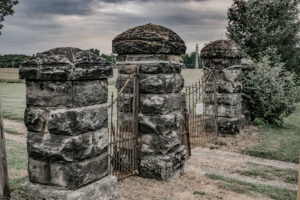
The mill sat on the Ohio and Erie canal. With a plethora of small boats and a private boat yard, the Adams brothers built warehouses on the property to help create makeshift hideouts for runaway slaves. Boats would haul flour to New Orleans and pick up slaves on the run and return to the mill. The slaves would then be separated and sent in different directions with clothes, food, and money to get their new lives underway.
As the rumors of the brother’s nobility spread, so did their popularity among the locals. This surprisingly brought in more business and wealth to the area. George and Edward began stepping away from the day to day operations and began dabbling in the stock market. They both began their own families but stayed very close, so close that they built identical mansions in different locations in Ohio.
Edward’s home was built close to the mill and even landed the area’s namesake of Adam’s Mills. George constructed his mansion north of Dresden in Trinway and dubbed it the Trinway Mansion. Their mansions ran a total of $40,000.00 each, roughly $1.2 million per mansion in 2019 equivalency.
![]()
![]()
![]()
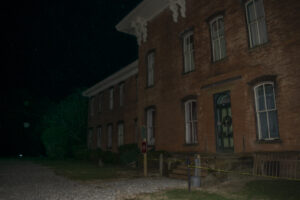
With the stock market growth, the Adams brothers became a large part of the upper class in Ohio. They teamed up together with other well-known prosperous Ohioans and created their own stock company. The first venture for this group was to design and construct a large suspension bridge over the Muskingum River. George fronted most of the cost and, after years of success as a toll bridge, he sold it to the county.
Relishing his success, George and his wife, Clarissa, raised four children in the Trinway Mansion. However, tragedy once again struck. Clarissa fell ill and died quickly in 1850. George was heartbroken and distraught. He mourned for years, closing himself into the mansion and rarely being seen in public. His children were raised by the nannies and George bowed out of he and Edward’s business. Eventually, he fell in love with one of his housekeepers, Mary. Mary was roughly twenty years younger than George, but they were happy and in love and after they married, she moved into Trinway Mansion with him.
Once again, George’s home became lively – George and Mary raised ten children, six of their own and four from Clarissa and George. This did not last long, however, as odd events began to occur in the mansion. Mary and her children would feel ill in certain locations in the mansion. On a few occasions, Mary would see a woman roaming the halls and would keep her awake for nights on end. She recognized this woman as George’s first wife, Clarissa. With these strange sightings, and George’s want to keep Mary happy, he began construction on a new, larger home for them. This home would become known as Prospect Place. George went on record stating that “bad memories” lingered in the last home and that he had to move on with his new life.
Unfortunately for George, upon completion of this new grand mansion, a fire burnt it to the ground. It was a suspected arson which began the fire. The second mansion, designed the exact same (except for a few more modern fire preventatives), was built on the existing foundation of the first structure.
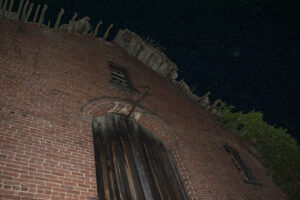
There are two stories rumored to who started the fire. The first is an old Native American woman who threatened George and his family that set the house on fire proving her curse that terrible things would happen upon that ground. She claimed that they built the mansion on ancient burial grounds. She was named “Satan” by the local community. The second is that of a disgruntled bricklayer who boasted in bars after the fact that he burnt the house to the ground. In fact, he was arrested and jailed in Columbus for this crime. He did escape, after working to build the jail he knew some ways out of it, but he was killed after trying to rob a local store.
Being completed in 1857, the mansion featured groundbreaking, and unheard of for the time, inventions that had never before been undertaken in private home construction. It included indoor pressurized plumbing with hot and cold running water systems linked to two separate coal stoves. This mansion also incorporated a type of refrigeration used to keep food necessities cold such as milk, butter, and cheese. A simplistic air conditioning system was also incorporated in the home pulling the cold air from the basement upstairs to the living areas and bedrooms. The mansion boasted enormous sitting rooms and parlors, numerous bedrooms, and a separate servant wing. The elaborate woodwork stretched throughout the house only being outdone by grand marble fireplaces and expansive staircases.
Returning to his civic duties, George opened his home to his Underground Railroad operation. Inside the massive house, George had created specific additions and improvements to help aid his cause. He knew that he endangered himself and his family by taking place in such a large part of the slavery abolishment movement that he made as many attempts to cover his tracks as possible. Above the house, in the dome-like addition, was utilized as a signaling tower. There were locations inside the windows where lamps would be hung, letting his colleagues know that it was safe to bring in the fleeing slaves. An internal well was located in the basement of the mansion so the slaves and servants could fetch water without leaving the property. There was a partial tunnel dug leading to an external window, the “tunnel” was only about ten feet long, but it was believed that it was used as a last-minute hiding spot for the slaves if any bounty hunters came looking for them.

Local legend tells of a bounty hunter, who was turned away from the mansion, was followed and kidnapped by the slaves he was searching for. This bounty hunter was dragged back to one of the barns on the property and he was tortured and eventually killed, slowly, for his crimes against slaves.
By the start of the Civil War, the Adams’ allowed for any Union soldier to stay at Prospect Place when they needed a place to stay or rest. Even though the area was never in imminent danger, Prospect Place was labeled as the Union headquarters of the region.
Following the Civil War, George and Mary enjoyed a quiet and peaceful home life in Prospect Place. He dabbled in the railroad industry and was even named director of the Steubenville and Indiana Railroad. George eventually purchased and ran the Cincinnati and Muskingham Valley Railway system.
After a long and prosperous life, George Adams passed away in 1879 at 79 years old. His wealth was distributed throughout his family to all his children and his wife. Mary moved out of Prospect Place and it was officially inherited by their daughter Anna and her husband William Cox.
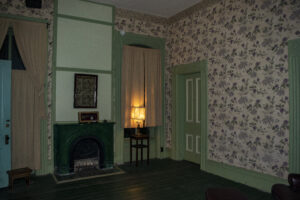
In time, William Cox would spend the vast fortune he and Anna acquired, and he disappeared. It is rumored that he ran away with his bisexual lover to California, abandoning his family and home. While living alone in the mansion, Anna joined in her father’s civic duties and took in homeless and abused women. When a major train crash occurred in 1912, Anna was the first to volunteer her home to act as an emergency hospital for the survivors and a morgue for the not so lucky who perished in the accident.
Anna remained in Prospect Place and passed the property along to their son George Cox. He owned and lived at Prospect Place until 1969 when he sold it to his cousin, Eugene Cox. Eugene owned a gravel mining company, Cox Gravel, which he utilized the mansion and property to operate out of until his death in 1990.
Following Eugene’s passing, Prospect Place was scheduled for demolition due to poor upkeep and maintenance. However, David Longaberger purchased the mansion upon hearing about the demolition. Being a local businessman and preservationist, he knew about the history of the old residence. David planned a full restoration for Prospect Place but put the project on hold with his holdings and funding decreasing in the mid 1990’s. Unfortunately, David passed away unexpectedly from cancer in 1998.
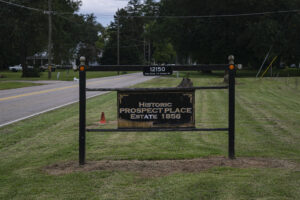
George J. Adams, great-great-grandson of George Adams, purchased the property in 2001 with the intention of opening a restaurant in the mansion. However, shortly after the purchase, the September 11 attacks occurred putting a hold on all his funding. With limited resources and income, George J. Adams opened a not-for-profit educational center in the mansion. The G.W. Adams Education Center was born and officially opened in 2003. The center is utilized to preserve history and act as a resource center for Underground Railroad workings that occurred inside the mansion and on the property.
George J. Adams formally retired and stepped down as the Chairman of the Board for the education center in 2017, but his will and wishes to continue to restore the mansion have been undertaken by the Board of Trustees who took his place. The G.W. Adams Education Center is still in operation and is thriving today.
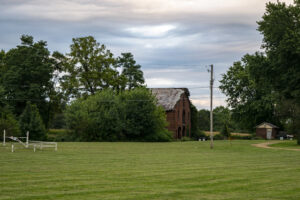
Paranormal Experiences
There has been an incredible amount of energy expended in Prospect Place and surrounding those who once resided there. With the incredible history, and plentiful amount of tragedy that occurred throughout its’ past, Prospect Place holds unimaginable tales of heroism, woes, and death. These people who once thrived here and perished here have left incredible imprints that seem to withstand the sands of time and bend the laws of reality. Paranormal encounters run rampant in the once glorious mansion. Visitors experience everything from phantom footsteps to sounds of laughter to the lurking of full body apparitions. To add to the mystique, there are rumors of a satanic cult who utilized the building for its’ energy and performed rituals on site.
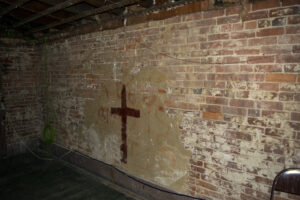
![]()
There are a plethora of spirits who are said to reside in the mansion, far past their earthly expirations. One of the more predominant and common sightings is that of a shadowy figure who stands on top of the main staircase. This man is said to be seen in formal period attire and has been explained sporting a long, bulky beard. It is believed that this is none other than George Adams, watching over his home in the afterlife. Another legend explains that this may be the spirit of William Cox who is doomed to look on after his desertion and disappearance.
In the servant’s quarters section of the mansion, children’s laughter have been recorded, as well as bellowing cries, perhaps those of a heart broken mother or wife. It is rumored that a child of a servant fell from the domed portico area and died in the 1860’s. Supposedly, this occurred during the winter and with the ground frozen solid, they had to keep her body in the house until spring time thawed out the ground for a proper burial. Her mother was said to visit her body every day until she was finally laid to rest. It is in the servant’s quarters where both the girl and mother have been seen by the naked eye. The little girl has been seen playing jump rope and hopscotch, while her mother has been said to pace back and forth in front of the fireplace.
![]()
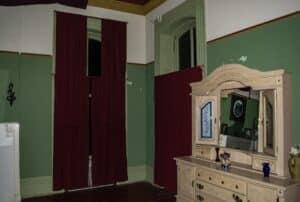
On the second floor, in the hallway that leads to the children’s’ bedrooms, there have been two apparitions – one seen, one heard. Anna Adams died from pneumonia in 1924. She did not pass away in the mansion, but rather in a nearby hospital. However, she was said to enjoy her life the most at Prospect Place regardless of being abandoned by her husband, William. Anna has been seen wondering the hallway in along white nightgown. George Adams has also been recorded calling out for Mary, his second wife and the reason Prospect Place was built, in this hallway. His voice tends to carry but is surprisingly clear when calling out for her.
The basement may be the most notorious, and common location to spot specters from the past. The typical feeling is that the spirits of slaves on the run are still seeking safety here underneath Prospect Place. A young, black woman has been spotted momentarily, only to disappear after a quick glance. It is noted that her head appears to be bandaged with blood spots seeping through. Even though the basement acted as a safe haven for runaway slaves, it was also some of their final resting places. As slaves found shelter at Prospect Place, they did not always show up in the best condition. As they arrived, some were badly wounded from gun shots and animal bites. Since they had to hide their every movement from local authorities and bounty hunters, it was decided to bury any of the deceased slaves right under the basement floor as to not attract attention. These slaves have been said to wonder the basement aimlessly, still trying to outrun their captors and escape to freedom. Their shuffling feet and moans of pain and agony have been heard echoing throughout the basement rooms. The basement is also the location of the makeshift hospital after the train accident in 1912. Many of the injured passengers died awaiting help in that very spot, while others who had already perished were simply stacked in piles of burnt flesh in other spots in the basement.
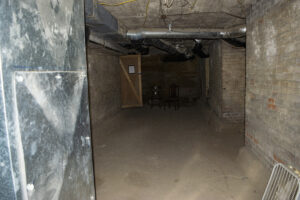
Outside the mansion, but still within the confines of the property, sits the old barn where the bounty hunter was said to be tortured and killed. A dark shadow has been captured by photograph inside the barn and some visitors even claim to be touched. His spirit is said to still be angry with the harsh justice he received and can be attributed to the thrown tools and slamming doors.

What did you think?
Drop a comment below.
